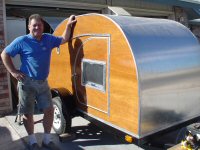fonsan wrote:I have been following yours on youtube and it is very inspiring.
Would it be feasible with a single layer of 6oz for large flat surfaces? (or even lighter)
If you would redo your camper would you consider using less epoxy and fiberglass?
Can't wait to see your camper fully finished

Thanks Fonsan! I absolutely overdid it with the glass in regards to weight. If light weight were the only parameter I was trying to meet I would be absolutely comfortable with a single ply of 6oz glass. Especially if you're okay with doing a little repair work here and there as needed.
The exterior of my build is three plies of 6oz glass with an additional 3 plies on all the radiused joints. I tend to be rough on things and live in an area with Gnarly thunderstorms, tornadoes, and hail on average of 1/2" diameter. Dale (the wonder dog) and I will find a nice ditch to lay in in the event of a tornado, but a hailstorm or three is not out of the question in its first season of use.
With all that said I am extremely light compared to commercial truck campers. Im estimating its around 200lbs currently and should be under 3-350 with the added weight of the 12v system, water system, 270 awning, etc. Most commercial options start at 750lbs and up. Heck even the fiberglass camper shell that I harvested the windows out of is significantly heavier than the total build as it sits.
Burt Rutan is the godfather of foam-core fiberglass. Incredible mind on that guy.
fonsan wrote:GPW wrote:" I am starting to realize that what I am asking about is the rigidity of the structure and not the surface resistance to damage as it seems that the rigidity will dictate the thickness of the fiberglass cloth" .
If you're worried about the rigidity of the structure , just THICKER foam ... Using more f/glas for "structure" will only make it Heavier ...

I tend to agree,
https://explorecomposites.com/articles/ ... tructures/Doubling thickness more than doubles the "Relative stiffness" and the stiffness gain seems to be even more advantageous past 1 inch (2.54cm)
I have 4,5 and 8 cm xps foam available to me in theory combinations could be glued (4+5 yielding 9cm)
Absouletly correct! I would have never guessed that my roof would be walkable, but its extremely rigid with 2" or 5cm foam. As explore composites points out the foam is basically the "web" of the beam. Its takes much more force to deform a 12" beam vs an 8" with the same web thickness.
fonsan wrote:https://www.homebuiltairplanes.com/forums/threads/testing-xps-foam-for-epoxy-adhesion-bonding.34960/page-2#post-571806
"80gsm/10mm XPS backing is enough to require not-accidental force to push through a surface."
80gms is roughly 3osy I think? Freedom units is my forte...sorry. In my testing I could dent the foam with my thumb with a single layer of 4osy glass.
This brings up a good point. Make up a few test panels, maybe 20cmx20cm with varying layer counts and foam thickness, then do some destructive testing. Its great fun and will help you decide on what specs are most desirable to you.






 , then I should go for either 6oz or 8oz (168gsm or 224 gsm) whatever I can get a hold of. Very interesting that 4oz will be dented by thumb pressure, that gives me an excellent idea of what I can expect. The savings of going to 4oz are minuscule and really low weight plain woven cloth is actually more expensive here than 6-8 oz.
, then I should go for either 6oz or 8oz (168gsm or 224 gsm) whatever I can get a hold of. Very interesting that 4oz will be dented by thumb pressure, that gives me an excellent idea of what I can expect. The savings of going to 4oz are minuscule and really low weight plain woven cloth is actually more expensive here than 6-8 oz. 

